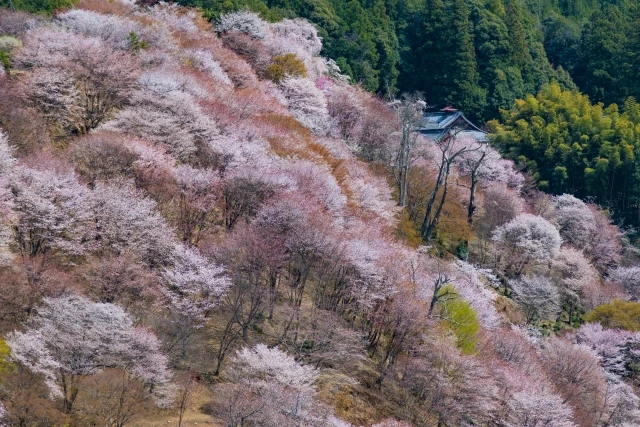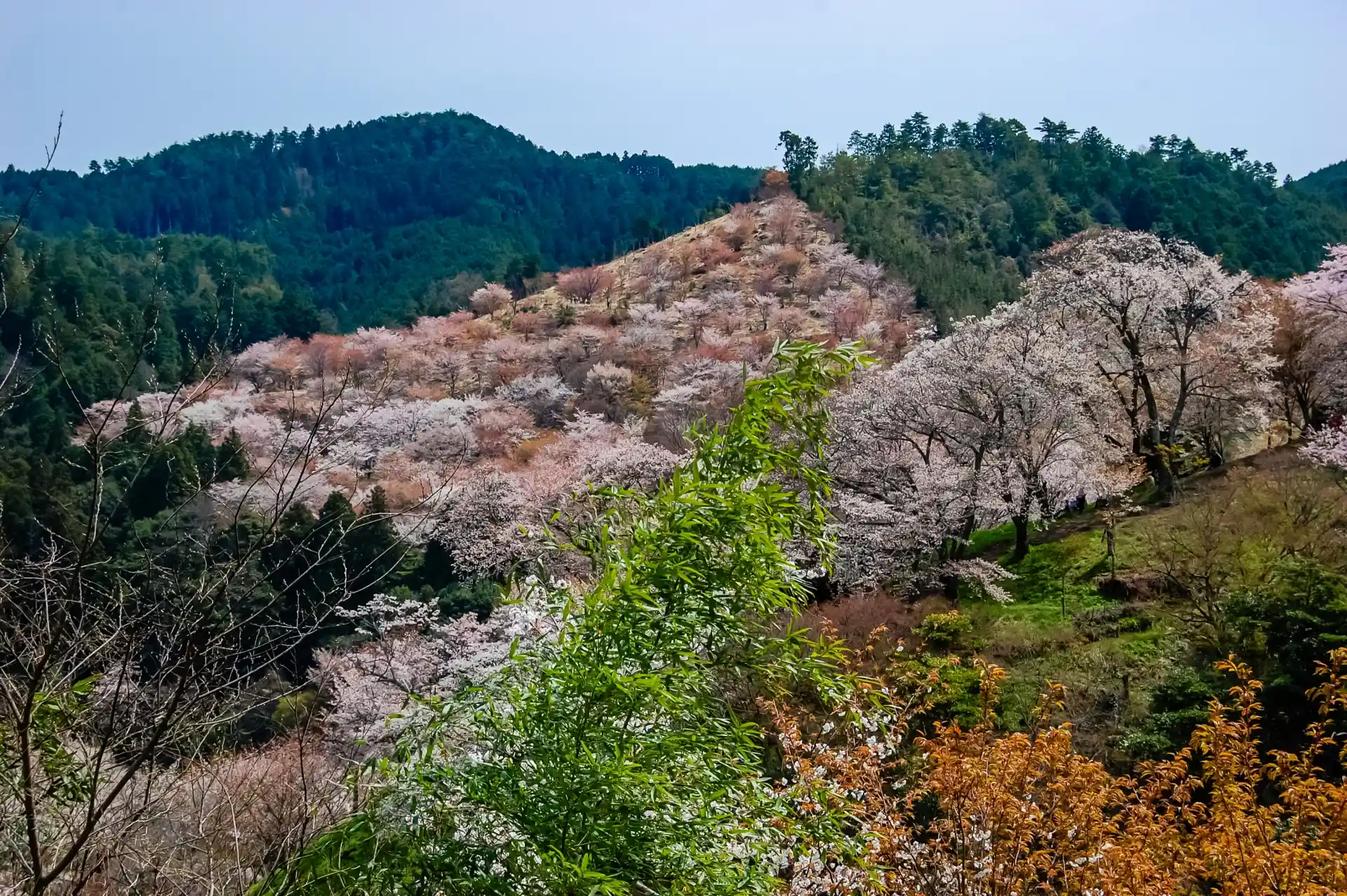Cherry blossoms (sakura) are one of the reasons tourists visit Japan. Yoshino Mountain, renowned for its stunning cherry blossom scenery, offers an extraordinary wedding experience.
Here is some wedding information, such as the wedding venues, locations, wedding packages, etc. Explore and let’s make the idea happen on Yoshino Mountain!
Introduction
Yoshino Mountain is one of the most beautiful places to have a wedding in the Spring (March-May). There will be 30,000 cherry blossom trees with 200 species, mostly White Yamazakura. You will see different Sakura scenery depending on which area you are in.
Yoshino Mountain is also known for its number of shrines and temples. In the old times, people thought that god lived in the mountains, and people used to think Yoshino Mountain was an ideal place for gods to live.
As a result, this area became a religious city, where ascetic practitioners gathered and where the capital of the Southern Dynasty was located during the Nanbokucho(南北朝) Period (1336-1644).
Due to its long history, Yoshino Mountain holds many shrines and temples that hold UNESCO. It’s a sacred, beautiful, and traditional place to have a wedding in Japan.
Planning Your Cherry Blossom Wedding
Plan your visit around mid-April to enjoy the cherry blossom at the peak. It used to bloom in late March, but it has been shifting later due to global warming.
Also, Yoshino Mountain usually starts blooming from the bottom, so mid-April should be the best time to look at all of the cherry blossoms.
To reach the top of Yoshino Mountain, you can move according to the below steps:
- Arrive at Yoshino station (Kintetsu)
- You can take the ropeway near Yoshino station to Shitasenbon (the entrance of the mountain)
- Take a bus from Yoshino Jingu to Okusenbon, the deepest in the mountain
In the cherry blossom season, the bus will come to Yoshino station (Kintetsu) and bring you to Naka Senbon (2nd lowest elevation area).
From Nara Park, which is famous for vowing deers, it takes about 1 hour and 11 minutes to reach Yoshino station (Kintetsu).
You have 4 areas where you can celebrate your wedding: Shita Senbon, Naka Senbon, Ue Senbon and Oku Senbon. This is the name for each area that has different elevations.
Usually, Japanese traditional weddings will be held in temples and shrines. It will be a great idea to ask the temples and shrines if they accept English-speaking wedding ceremonies there if you are interested.
Ceremony Locations

Each elevation zone offers a distinct scenery. Here are some temples and shrines you can consider in different elevation areas. You can hold the ceremony in the morning or afternoon, and enjoy the illumination with your loved ones in the evening. Let’s enjoy the photo shoot at the great illumination spots.
Shita Senbon(下千本)
Shita Senbon literally means ‘below one thousand pieces’. It is known as the entrance to the mountain. They had the illumination around Nanamagari(七曲)and Dou no Torii(銅の鳥居) in 2024.
Temple/Shrine you can consider for wedding:
Naka Senbon(中千本)
‘Naka Senbon’ means ‘middle 1,000 pieces’ in Japan. This area has many shrines and temples compared to other areas. You might be able to enjoy the illumination at Tounanin(東南院).
Temple/Shrine you can consider for wedding:
- Kissui Shrine(吉水神社)
- Kinpusenji Temple(金峯山寺)
- Nyorinji Temple(如意輪寺)
- Katte Shrine(勝手神社)
- Dainichiji Temple(大日寺)
- Tonanin(東南院)
Ue Senbon(上千本)
Ue Senbon means “up 1,000 pieces”. It is around 370~600m height of the mountain. The panorama scenery is breathtaking! They had the illumination in Nanchoumyou Houden(南朝妙法伝)in 2024.
Temple/Shrine you can consider for wedding:
Oku Senbon(奥千本)
Just as the name Oku Senbon implies, this is the highest and the deepest area in the mountain. It literally means “deep 1,000 pieces” and it is located at 600~750m in height of the mountain. You might be able to look at the illumination at Daitou no Miya(大塔の宮)where they had it in 2024.
Temple/Shrine you can consider for wedding:
Wedding Packages

You will need to find your own wedding planner to have a wedding in Nara prefecture.
Here are some recommendations:
Wedding Planner: Destination Wedding Japan
Wedding Planner: Ayaka Ishimura
Pre-Wedding Photography: STUDIOZERO
Here are some accommodations you can stay around Yoshino Mountain:
| Accommodations | Information |
| Yoshinoso Yukawaya(吉野荘湯川屋) | Located in Shita Senbon. 5 mins walk to Kuodo(蔵王堂), Kinpu Shrine Tel: 0746-32-3004 |
| Yoshino onsen motoyu(吉野温泉元湯) | Located in Naka Senbon. 16 mins car drive to Yoshimizu Shrine Tel: 0746-32-3061 |
| Chikurinin Gunpoen(竹林院群芳園) | Located in Ue Senbon. 1 min walk from Sakuramoto Bo(櫻本坊) Tel: 0746-32-5011 |
Practical Considerations
When you come to Japan for a wedding, it’s harder to understand the arrangement in somewhere you are not living. Here are some things you should consider when having a wedding in a foreign land.
1) The weather changes
In the event of rain, the ceremony plans may change. Usually, you will walk outside during the ceremony, but you may spend your time indoors more.
You also might not be able to look at the cherry blossoms as clearly as it usually does. Still, usually, the shrines and temples do not allow you to cancel due to the weather.
In Japan, having a wedding on a rainy day will bring luck, so don’t worry even if it’s raining!
You might want to ask your wedding planner what will be changed when it’s raining and if there are any other ideas.
2) Guest capacity
A wedding ceremony in a shrine/temple usually holds a smaller guest capacity because the space is limited.
For example, Yoshino Jingu allows 32 pax to join the ceremony and Yoshimizu Shrine allows 2 pax.
You may want to check with the venue on the guest capacity and plan who you would like to call!
3) Local vendors and services
You will need local vendors to communicate linguistically and culturally.
Sometimes there are local cultures and traditions that you might need to know beforehand. As most Japanese people speak Japanese, some temples and shrines may not accommodate you if you do not speak Japanese.
It’s highly recommended to have a Japanese-speaking wedding planner to assist your language and cultural barrier.







